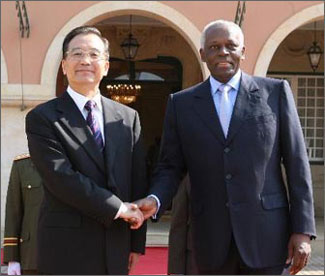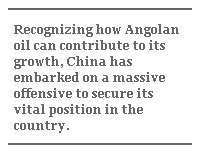China’s Portuguese Connection
China’s Portuguese Connection

HONOLULU and SINGAPORE: Unnoticed by many observers has been China’s growing relationship with the Portuguese speaking world, a grouping composed of eight nations with a combined population of 230 million and trade with China totaling $19 billion. The eight countries are brought together under the Comunidade dos Países de Língua Portuguesa (CPLP), or Community of Portuguese Language Countries, and consists of the following nations: Angola, Brazil, Cape Verde, Guinea Bissau, Mozambique, Portugal, the Democratic Republic of São Tomé and Príncipe, and the Democratic Republic of Timor-Leste.
China has several reasons for pursuing a relationship with CPLP: First and foremost is energy security. Over the past few years, energy security, particularly oil supply security, has become a priority for the Chinese leadership. China is now the world’s second largest consumer of energy resources after the US. More than 60 percent of China’s crude oil imports come from the Middle East, and Beijing views this dependency as a strategic vulnerability because of ongoing political instability and US military preponderance in and around the region. China is therefore trying to diversify its energy imports away from traditional sources in the Persian Gulf. These include CPLP countries such as Angola, Brazil, Mozambique and Timor-Leste. Second, Beijing is keen to exploit CPLP countries’ rich natural resources to fuel the country’s own breakneck economic growth. Third, 230 million people represent a major market for Chinese manufactured goods. And finally, the Portuguese-speaking organization represents a diplomatic community, one that China can utilize to restrict Taiwan’s international space.

Without question, Angola is China’s most important partner on the African continent. The country is the second largest oil producer in Africa and possesses one of the world’s largest diamonds fields. In February 2006 Angola became the largest supplier of crude oil to China, beating Saudi Arabia and Iran into second and third place. Recognizing how Angolan oil can contribute to its continuing growth, China has embarked on a massive offensive to secure its vital position in the country. During Vice Premier Zeng Peiyang’s visit in 2005, China granted the Angolan government a $6.3 million interest-free loan and additional $2.2 billion in soft loans in early 2006. Agreements have also been signed in the telecommunications sector, with China pledging to invest $400 million in Angola’s Telecom and a further $100 million to upgrade Angola’s military communications. Chinese companies have also participated in the construction of railroads, shopping centers and housing projects, and construction of a major oil refinery is planned. In 2005 Angola was China’s second largest trading partner in Africa, with a trade volume of $5 billion.
China is also increasing activity in Mozambique. While Chinese foreign direct investment in Mozambique remains small at $9 million in 2005, one should take into account that it has grown from a mere $436,000 in 2004. Trade between the two nations totaled $160 million in 2005. The small amounts belie the importance of Mozambique to China, as the country is believed to have large reserves of untapped natural gas and oil. China is also becoming a major source of credit with a $2.3 billion soft loan granted this year for the construction of a major dam on the Zambezi River.

Due to chronic instability in Guinea Bissau and Cape Verde’s small size and lack of raw materials, these two CPLP members are the least important for Beijing. However, Beijing retains a diplomatic presence to prevent these countries from turning to Taiwan, as tiny São Tomé and Príncipe did in 2002. As a result, São Tomé and Príncipe are excluded from any CPLP-China cooperation.
While trade between China and Timor-Leste was a mere $1.7 million in 2005, recent agreements between Dili and Beijing are likely to change that. In 2004 PetroChina concluded a multimillion dollar seismic study to assess the profitability of inshore oil and natural gas reserves. Although information is limited, some sources speculate that China plans to construct a pipeline to bring oil and natural gas from the island’s interior to Chinese vessels on the northern coast. To further consolidate its influence in the fledgling country China has financed highly visible construction projects, such as the presidential palace and the foreign ministry building. Beijing has also stepped up defense and security cooperation with Dili.

In December 2005 China and Portugal established a strategic partnership. While a small power, Portugal has been a useful friend, with Lisbon well disposed toward ending the EU arms embargo on China. Portugal’s 500-year-old relationship with Africa and its strong presence on the continent that goes beyond its former colonies are valuable assets for China. Beijing values its ties with Lisbon – enough to deem the country as one of five in Europe awarded status of strategic partner.
China’s most important CPLP trading partner is Brazil. In 2006 the volume of bilateral trade reached $10 billion. On the energy front, China is investing up to $5 billion in the construction of a gas pipeline from Macaé to Salvador. Beijing has also shown interest in Brazil’s large uranium reserves and invited Brazilian companies to participate in the construction of nuclear power plants in China. China and Brazil have launched several jointly developed satellites, and both countries are reported to be cooperating in the development of an aircraft. With a population of 186 million, a fast-growing economy and a highly developed industrial sector, Brazil is by far South America’s dominant power and increasingly becoming China’s main partner on the continent.

Having relations with CPLP members is hardly unique, but China’s methods are quite farsighted, attesting to the increasing sophistication of Chinese diplomacy. Unlike other powers who have engaged in close relations with particular CPLP countries – but had little or no interaction with other members – China not only connects with the various CPLP nations on a bilateral basis but also as a group. With the former Portuguese enclave of Macau, sovereignty of which returned to the PRC on December 20, 1999, serving as a hub, China has organized a series of initiatives that not only bring the Portuguese-speaking nations closer together, but also closer to China. In 2003 China and the CPLP signed a Trade and Cooperation Agreement, and agreed to hold triennial meetings with CPLP and PRC trade ministers. Similar arrangements are planned for other portfolios.
Over the past year or so, China reduced the debts of Africa’s CPLP members, tripled aid to Timor-Leste, awarded Portugal the status of strategic partner and made available $8.2 million in interest-free credit for CPLP members. Negotiations are also under way to establish an investment bank to increase China-CPLP trade relations and fund joint projects. China has also provided generous support to host the first ever CPLP games to take place in Macau in September 2006. Further evidence that China seeks to foster ties with the Lusophone world as a group was its decision in May 2006 to grant Guinea Bissau a $1 million aid package to help the impoverished nation host the CPLP heads-of state-summit in late 2006. On the diplomatic front, China has an impressive number of Portuguese-speaking diplomats, many of whom have served for long periods of time in CPLP countries. Overall, Beijing’s CPLP strategy has been successful in enhancing China’s vital interests in a world of 230 million people spread across four continents.
Loro Horta is enrolled in Strategic Studies at the Institute of Defence and Strategic Studies, Nanyang Technological University in Singapore. He lived and worked in Mozambique for several years. Ian Storey is an assistant professor at the Asia-Pacific Center for Security Studies in Honolulu. The views expressed in this article do not necessarily reflect the official policy or position of the US Government or any of its agencies.